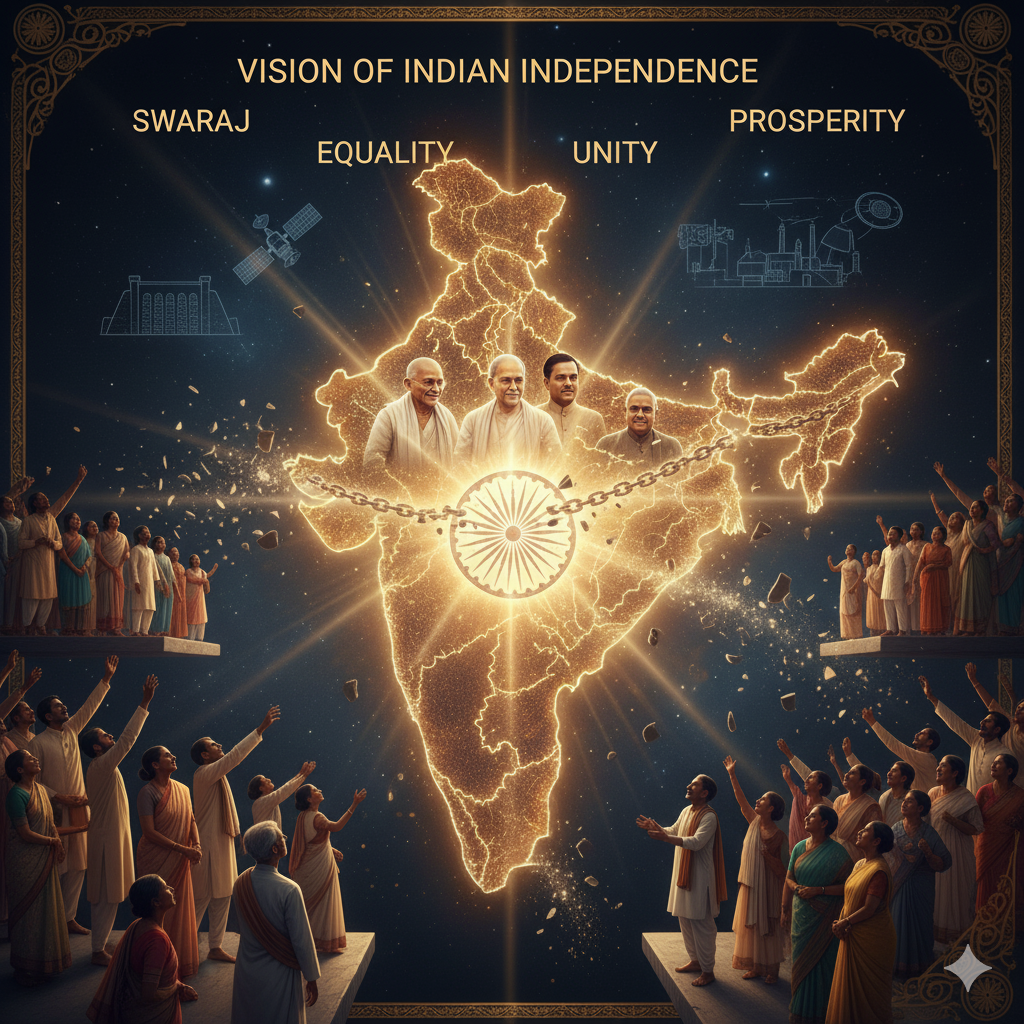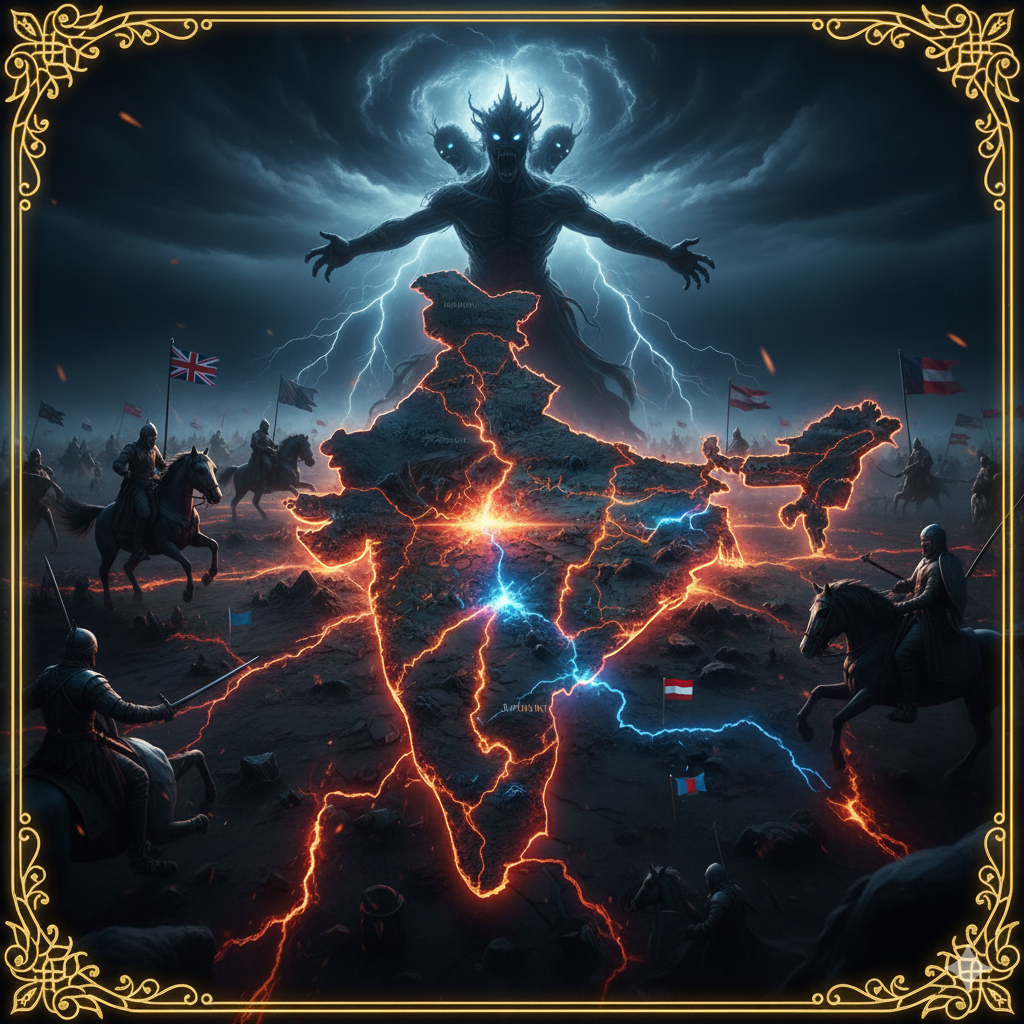Introduction
The early phase of the Indian national movement was primarily political in nature — its central goal was the attainment of Swaraj, or self-government, within the British Empire. However, as India moved into the 1920s, the vision of independence underwent a significant transformation. The experience of mass movements, exposure to global ideas, and the socio-economic realities of colonial rule led Indian nationalists to broaden their objectives. Independence was no longer viewed merely as a change in rulers but as the beginning of a new social, economic, and moral order.
The 1920s marked a watershed in India’s struggle for freedom. It was the decade when the nationalist movement transitioned from elite politics to mass politics under Mahatma Gandhi’s leadership. It was also the period when new ideologies — socialism, communal harmony, women’s emancipation, peasant and worker rights — began to shape the vision of a free India. This essay examines the significance of these new objectives and how they redefined the meaning of independence for the Indian people.
The Early Vision of Indian Independence
Before exploring the changes of the 1920s, it is essential to understand the earlier conception of Indian independence.
1. Moderate Phase (1885–1905): Political Reforms within Empire
During the early phase of the Indian National Congress (INC), leaders such as Dadabhai Naoroji, Gopal Krishna Gokhale, and Pherozeshah Mehta sought greater Indian participation in administration. Their objectives were:
- Expansion of legislative councils
- Indianization of civil services
- Reduction of military expenditure
- Safeguards against economic exploitation
Their vision of independence was constitutional, moderate, and loyal to the British Crown, aiming at self-government within the empire rather than complete separation.
2. Extremist Phase (1905–1917): Demand for Swaraj
Leaders like Bal Gangadhar Tilak, Bipin Chandra Pal, and Lala Lajpat Rai injected a new spirit of nationalism. The demand for Swaraj became central, coupled with emotional appeals to India’s cultural and spiritual unity. However, the struggle remained largely urban and middle-class in nature.
By the end of World War I, the limitations of both moderate petitions and extremist protests became evident. The 1920s, therefore, became the decade of new ideas, broader goals, and mass mobilization.
New Contexts of the 1920s: A Turning Point
Several historical developments converged to reshape the nationalist movement and its objectives in the 1920s:
1. Impact of World War I
The war intensified India’s economic exploitation — heavy taxation, rising prices, and unemployment increased people’s hardships. This fueled resentment against British rule and created fertile ground for radical ideologies like socialism and communism.
2. Influence of the Russian Revolution (1917)
The success of the Bolshevik Revolution inspired Indian youth and intellectuals to think beyond political freedom. They began to see independence as inseparable from social and economic justice. The idea of equality and workers’ rights became part of the nationalist discourse.
3. Disillusionment with British Promises
The Montagu-Chelmsford Reforms (1919) and the subsequent Rowlatt Act exposed the hollowness of British liberalism. The brutal Jallianwala Bagh massacre (1919) destroyed faith in the British sense of justice and transformed Indian nationalism into a mass-based, anti-imperialist struggle.
4. Rise of Mahatma Gandhi
Gandhi’s entry into Indian politics brought a complete shift in strategy and vision. He expanded the meaning of freedom to include self-reliance, moral regeneration, communal harmony, and upliftment of the poor.
Thus, from the 1920s onwards, the movement for independence became multi-dimensional — political, social, economic, and moral.
New Objectives Added to the Vision of Indian Independence
1. Political Independence: Complete Swaraj
Before the 1920s, leaders demanded Dominion Status (self-rule within the British Empire). However, the growing realization that true freedom could not coexist with colonial control led to the demand for Purna Swaraj (Complete Independence).
- The Nagpur Session (1920) redefined Congress’s goal as achieving self-rule through non-violent means.
- By 1929, under Jawaharlal Nehru’s leadership, the Lahore Congress declared Purna Swaraj as the ultimate goal, symbolized by the first Independence Day on January 26, 1930.
This represented a decisive ideological shift — from reform to revolution in constitutional terms.
2. Economic Independence and Social Justice
One of the most important new objectives that emerged during the 1920s was economic self-reliance and social equality.
(a) The Economic Drain Realization
Leaders like Dadabhai Naoroji and R.C. Dutt had already exposed the economic drain under British rule. The 1920s saw this idea mature into a national demand for economic justice.
(b) Gandhi’s Vision of Self-Reliance
Gandhi emphasized swadeshi and khadi as symbols of economic freedom. He believed that political independence would be meaningless without:
- Rural industrial revival
- Dignity of labor
- Eradication of poverty
(c) Rise of Socialist Thought
A new generation of leaders such as Jawaharlal Nehru, Subhas Chandra Bose, and Jayaprakash Narayan introduced socialist ideas. The Congress Socialist Party (1934) later institutionalized these ideals, emphasizing:
- State control over key industries
- Redistribution of wealth
- Protection of workers and peasants
Thus, economic independence became a core element of national independence.
3. Empowerment of Peasants and Workers
The 1920s also witnessed the emergence of mass organizations representing peasants and workers.
(a) Peasant Movements
Movements such as the Kisan Sabha in Uttar Pradesh, the Bardoli Satyagraha (1928) led by Sardar Patel, and the Eka Movement demonstrated that rural India was now an integral part of the nationalist struggle.
(b) Workers’ Movements
Industrial workers began organizing under trade unions. The All India Trade Union Congress (AITUC), founded in 1920, symbolized the growing awareness of labor rights and class consciousness.
(c) Inclusion in National Agenda
These movements influenced the Congress to recognize socio-economic justice as essential to freedom. The idea of “Poorna Swaraj” came to mean not just political liberation but economic empowerment of the masses.
4. Social Equality and Upliftment of Marginalized Groups
A major transformation in the 1920s was the inclusion of the marginalized — Dalits, tribals, women, and backward castes — into the vision of national freedom.
(a) Gandhi’s Efforts for Social Reform
Gandhi’s campaigns for Harijan upliftment, abolition of untouchability, and promotion of basic education (Nai Talim) redefined nationalism as a moral and social mission.
(b) Ambedkar’s Ideological Challenge
Dr. B.R. Ambedkar criticized both the British and upper-caste leadership of the Congress for neglecting Dalit issues. His demand for separate electorates and social justice introduced a new dimension of equality to the freedom movement.
(c) Rise of Women’s Participation
The 1920s saw unprecedented participation of women in public life — Sarojini Naidu, Kamaladevi Chattopadhyay, Aruna Asaf Ali, and others became symbols of gender equality in the national struggle. The All India Women’s Conference (1927) emerged as a platform for women’s rights.
5. Communal Harmony and National Integration
Communalism had begun to rise in the early 20th century due to British policies of “divide and rule.” Gandhi’s vision in the 1920s stressed the unity of Hindus, Muslims, Sikhs, and other communities.
- The Khilafat Movement (1919–24), despite its eventual decline, brought Hindus and Muslims together under a shared cause.
- Gandhi insisted that true Swaraj could not be achieved without Hindu-Muslim unity.
This objective of national unity became central to the broader vision of independence, though it faced severe challenges in the following decades.
6. Educational and Cultural Regeneration
The nationalist movement of the 1920s recognized that political freedom required an intellectual and moral awakening.
(a) National Education
Institutions like the National Council of Education, Banaras Hindu University, and Jamia Millia Islamia promoted indigenous education free from colonial influence.
(b) Cultural Nationalism
Figures like Rabindranath Tagore and Abanindranath Tagore emphasized cultural self-expression as part of freedom. Literature, art, and theatre became instruments for awakening national consciousness.
7. Constructive Programme and Rural Development
Gandhi’s Constructive Programme (1920s–40s) was a blueprint for social and economic reconstruction, emphasizing:
- Village industries
- Sanitation and hygiene
- Education for all
- Promotion of khadi
- Communal harmony
- Upliftment of women and Harijans
This transformed the nationalist movement from a mere political agitation into a comprehensive social revolution.
8. Global Vision and Anti-Imperial Solidarity
Indian leaders increasingly connected India’s struggle with global movements against colonialism and imperialism.
- Jawaharlal Nehru’s participation in the League against Imperialism (1927) and his later advocacy of Pan-Asian solidarity reflected this global consciousness.
- The freedom struggle began to identify itself as part of a worldwide movement for peace, justice, and equality.
The Changing Leadership and Ideological Pluralism
The 1920s also saw the emergence of a new generation of leaders who broadened the nationalist vision:
- Jawaharlal Nehru represented socialism and scientific modernism.
- Subhas Chandra Bose emphasized militant nationalism and planned industrialization.
- Gandhi represented moral and spiritual nationalism.
- Ambedkar represented social justice and equality.
This ideological pluralism enriched the national movement, making it more inclusive and dynamic.
Impact of the New Objectives
1. Transformation of Nationalism
The movement ceased to be merely anti-colonial and became a nation-building project. Independence came to mean a just, egalitarian, and moral society.
2. Expansion of Social Base
The inclusion of peasants, workers, women, and lower castes gave the movement a mass character. It was no longer confined to urban elites.
3. Emergence of a New Economic Vision
The idea of self-reliant villages, mixed economy, and state planning that shaped post-independence India originated in the 1920s.
4. Foundation for Future Policies
The goals of equality, secularism, and democracy, which later formed the Preamble of the Indian Constitution, were conceptualized during this period.
Conclusion
The 1920s marked a decisive shift in the vision of Indian independence. The freedom struggle evolved from a political campaign for self-rule into a comprehensive movement for social transformation. Independence came to signify the liberation of India’s millions from poverty, inequality, ignorance, and injustice.
New objectives — complete political independence, social equality, economic justice, communal harmony, gender empowerment, and moral regeneration — enriched the nationalist cause and gave it enduring depth. These ideals continue to shape India’s democratic ethos even today.
Thus, the Indian independence movement of the 1920s was not just a fight to end colonial rule; it was a revolution of ideas, envisioning a just and inclusive India — a vision that remains both a legacy and a challenge for contemporary society.




